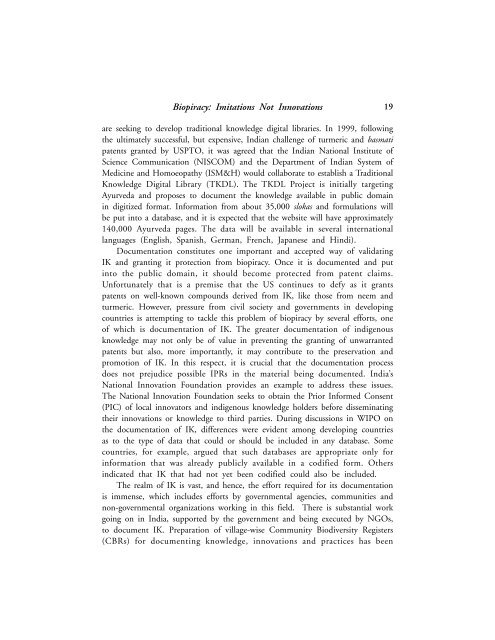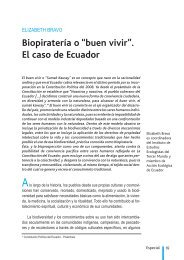BIOPIRACY Imitations Not Innovations - Biopirateria
BIOPIRACY Imitations Not Innovations - Biopirateria
BIOPIRACY Imitations Not Innovations - Biopirateria
You also want an ePaper? Increase the reach of your titles
YUMPU automatically turns print PDFs into web optimized ePapers that Google loves.
Biopiracy: <strong>Imitations</strong> <strong>Not</strong> <strong>Innovations</strong> 19<br />
are seeking to develop traditional knowledge digital libraries. In 1999, following<br />
the ultimately successful, but expensive, Indian challenge of turmeric and basmati<br />
patents granted by USPTO, it was agreed that the Indian National Institute of<br />
Science Communication (NISCOM) and the Department of Indian System of<br />
Medicine and Homoeopathy (ISM&H) would collaborate to establish a Traditional<br />
Knowledge Digital Library (TKDL). The TKDL Project is initially targeting<br />
Ayurveda and proposes to document the knowledge available in public domain<br />
in digitized format. Information from about 35,000 slokas and formulations will<br />
be put into a database, and it is expected that the website will have approximately<br />
140,000 Ayurveda pages. The data will be available in several international<br />
languages (English, Spanish, German, French, Japanese and Hindi).<br />
Documentation constitutes one important and accepted way of validating<br />
IK and granting it protection from biopiracy. Once it is documented and put<br />
into the public domain, it should become protected from patent claims.<br />
Unfortunately that is a premise that the US continues to defy as it grants<br />
patents on well-known compounds derived from IK, like those from neem and<br />
turmeric. However, pressure from civil society and governments in developing<br />
countries is attempting to tackle this problem of biopiracy by several efforts, one<br />
of which is documentation of IK. The greater documentation of indigenous<br />
knowledge may not only be of value in preventing the granting of unwarranted<br />
patents but also, more importantly, it may contribute to the preservation and<br />
promotion of IK. In this respect, it is crucial that the documentation process<br />
does not prejudice possible IPRs in the material being documented. India’s<br />
National Innovation Foundation provides an example to address these issues.<br />
The National Innovation Foundation seeks to obtain the Prior Informed Consent<br />
(PIC) of local innovators and indigenous knowledge holders before disseminating<br />
their innovations or knowledge to third parties. During discussions in WIPO on<br />
the documentation of IK, differences were evident among developing countries<br />
as to the type of data that could or should be included in any database. Some<br />
countries, for example, argued that such databases are appropriate only for<br />
information that was already publicly available in a codified form. Others<br />
indicated that IK that had not yet been codified could also be included.<br />
The realm of IK is vast, and hence, the effort required for its documentation<br />
is immense, which includes efforts by governmental agencies, communities and<br />
non-governmental organizations working in this field. There is substantial work<br />
going on in India, supported by the government and being executed by NGOs,<br />
to document IK. Preparation of village-wise Community Biodiversity Registers<br />
(CBRs) for documenting knowledge, innovations and practices has been



